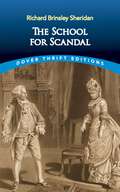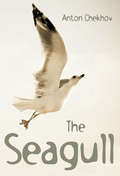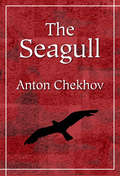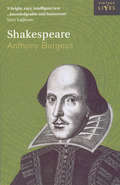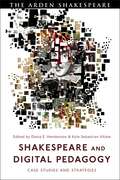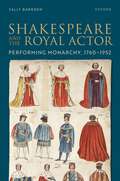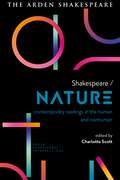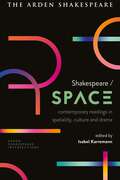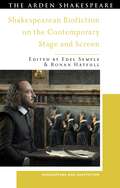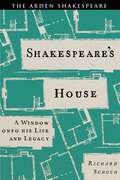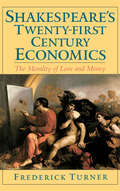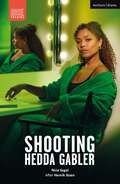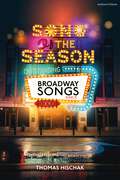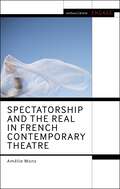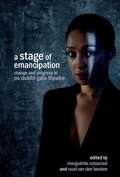- Table View
- List View
The School for Scandal: A Comedy... (Dover Thrift Editions)
by Richard Brinsley SheridanThe intrigues of such aptly named characters as Lady Sneerwell, Sir Joseph Surface, Lady Candour, and Sir Benjamin Backbite have amused theater audiences for more than two centuries. They are the invention of the Irish-born playwright Richard Brinsley Sheridan, and they unfold, collide, and backfire hilariously in his masterpiece, The School for Scandal, a play still considered by many the best comedy of manners in English.It is a comedy with two plots, one involving Sir Oliver Surface's attempts to discover the worthier of his two nephews, and the other unleashing Lady Sneerwell's strategies to ensnare both nephews and the hapless Lady Teazle in her designs. Both plots converge brilliantly in the screen scene — one of the most famous in all of theater.The School for Scandal reveals not only Sheridan's mastery of the mechanics of stage comedy, but also his flair for witty dialogue and obvious delight in skewering the affectation and pretentiousness of aristocratic Londoners of the 1770s. Its evergreen appeal makes it one of the most produced of all theater classics today, and one of the most delightful to read.
The Seagull
by Anton ChekhovAnton Chekhov's The Seagull was written in 1895 and first staged in 1896. It dramatises the romantic and artistic conflicts between four characters: the famous middlebrow story writer Boris Trigorin, the ingenue Nina, the fading actress Irina Arkadina, and her son the symbolist playwright Konstantin Tréplev. Though the character of Trigorin is considered Chekhov's greatest male role like Chekhov's other full-length plays, The Seagull relies upon an ensemble cast of diverse, fully developed characters. In contrast to the melodrama of mainstream 19th-century theatre, lurid actions (such as Konstantin's suicide attempts) are not shown onstage. Characters tend to speak in ways that skirt around issues rather than addressing them directly; in other words, their lines are full of what is known in dramatic practice as subtext. A play more character driven than plot driven, it remains a staple for theatrical production companies to this day.
The Seagull
by Anton ChekhovAnton Chekhov's The Seagull was written in 1895 and first staged in 1896. It dramatises the romantic and artistic conflicts between four characters: the famous middlebrow story writer Boris Trigorin, the ingenue Nina, the fading actress Irina Arkadina, and her son the symbolist playwright Konstantin Tréplev. Though the character of Trigorin is considered Chekhov's greatest male role like Chekhov's other full-length plays, The Seagull relies upon an ensemble cast of diverse, fully developed characters. In contrast to the melodrama of mainstream 19th-century theatre, lurid actions (such as Konstantin's suicide attempts) are not shown onstage. Characters tend to speak in ways that skirt around issues rather than addressing them directly; in other words, their lines are full of what is known in dramatic practice as subtext. A play more character driven than plot driven, it remains a staple for theatrical production companies to this day.
Shakespeare: A Story Of Shakespeare's Love-life (Vintage Lives #11)
by Anthony BurgessAmong Shakespeare's many biographers none brings to his subject more passion and feeling for the creative act than Anthony Burgess. He breathes life into Shakespeare the man and invigorates his times. His portrait of the age builds upon an almost personal tenderness for Shakespeare and his contemporaries (especially Ben Jonson), and on a profound sense of literary and theatrical history. Anthony Burgess's well-known delight in language infuses his own writing about Shakespeare's works. And in the verve of his biography he conveys the energy of the Elizabethan age.
Shakespeare and Digital Pedagogy: Case Studies and Strategies
Shakespeare and Digital Pedagogy is an international collection of fresh digital approaches for teaching Shakespeare. It describes 15 methodologies, resources and tools recently developed, updated and used by a diverse range of contributors in Great Britain, Australia, Asia and the United States. Contributors explore how these digital resources meet classroom needs and help facilitate conversations about academic literacy, race and identity, local and global cultures, performance and interdisciplinary thought. Chapters describe each case study in depth, recounting needs, collaborations and challenges during design, as well as sharing effective classroom uses and offering accessible, usable content for both teachers and learners.The book will appeal to a broad range of readers. College and high school instructors will find a rich trove of usable teaching content and suggestions for mounting digital units in the classroom, while digital humanities and education specialists will find a snapshot of and theories about the field itself. With access to exciting new content from local archives and global networks, the collection aids teaching, research and reflection on Shakespeare for the 21st century.
Shakespeare and Lecoq: A Practical Guide for Actors, Directors, Students and Teachers (Arden Performance Companions)
by Dr Abigail Rokison-Woodall Ed WoodallThis book provides actors, directors, teachers and students with a clear, practical guide to applying the work of influential theatre practitioner Jacques Lecoq to the process of rehearsing or workshopping the Shakespeare text. Written by theatre practitioner Ed Woodall, who trained with Lecoq himself, and Shakespeare academic Abigail Rokison-Woodall, this guide begins with warm-ups and ensemble-building, and moves through explorations of the story, the world of the play, the text, character emotion, thought and physicality and staging. Lecoq's method often relies on 'play', and play is often seen as trivial or inconsequential. This book argues that the more playful you are, the more playfully you investigate your speech or scene and the more physically motivated that playfulness is, the more vital and lifelike your acting of Shakespeare will be.
Shakespeare and the Royal Actor: Performing Monarchy, 1760-1952
by Sally BarndenShakespeare and the Royal Actor argues that members of the royal family have identified with Shakespearean figures at various times in modern history to assert the continuity, legitimacy, and national identity of the royal line. It provides an account of the relationship between the Shakespearean afterlife and the royal family through the lens of a broadly conceived theatre history suggesting that these two hegemonic institutions had a mutually sustaining relationship from the accession of George III in 1760 to that of Elizabeth II in 1952. Identifications with Shakespearean figures have been deployed to assert the Englishness of a dynasty with strong familial links to Germany and to cultivate a sense of continuity from the more autocratic Plantagenet, Tudor, and Stuart monarchs informing Shakespeare's drama to the increasingly ceremonial monarchs of the modern period. The book is driven by new archival research in the Royal Collection and Royal Archives. It reads these archives critically, asking how different forms of royal and Shakespearean performance are remembered in the material holdings of royal institutions.
Shakespeare in the Theatre: The Stratford Festival (Shakespeare in the Theatre)
by Dr Christie CarsonThis analysis of the Stratford Festival examines the full history of one of the largest and oldest dedicated centres for the performance of Shakespeare in North America. In English-speaking Canada, the Festival has become the unofficial national theatre, drawing both praise and criticism. Dividing its history into three distinct periods, the volume begins with the foundation of the company, moving through its middle years of expansion and securing stability, and ending with an exploration of staging Shakespeare in the 21st century. Through case studies of productions, covering each artistic director from Tyrone Guthrie to Antoni Cimolino, it highlights issues of national identity but also the relationship between actor and audience on the Festival's unique thrust stage. It not only explores the work of international stars such as Christopher Plummer, but also that of longstanding company members William Hutt and Martha Henry, emphasizing the Festival's collective spirit. This book argues that the Stratford Festival holds an influential position in the theatre world generally and in the Shakespeare performance environment specifically. Initially this was because of the original stage built for its opening, but increasingly it has been due to the way that it has used Shakespeare's work to articulate complex questions about identity and utilized technology to reach new audiences. The Festival and its collaborative working methods grew out of a particular social and political climate, and when the actors and directors who trained at the Festival took their training and its influences elsewhere, they spread its impact.
Shakespeare in the Theatre: Tina Packer (Shakespeare in the Theatre)
by Katharine GoodlandThis book examines the work of acclaimed director Tina Packer, founder of Shakespeare & Company, whose ground-breaking approach to performing Shakespeare has made her company among the most vibrant and enduring Shakespeare theatres in America. Tina Packer directed her first Shakespeare play at London Academy for Music and Dramatic Art in 1971. More than 50 years later she continues to direct and teach at Shakespeare & Company, which she founded in Lenox, Massachusetts in 1978. Drawing on new interviews with the original casts and creative teams as well as Tina Packer herself, this book is the first comprehensive analysis of all of her professional Shakespeare productions in their cultural and historical context. Over a career that spans 5 decades, Packer has directed or acted in virtually all of Shakespeare's plays, along with many other classical and contemporary works. As artistic director she guided her company through times of expansion as well as belt-tightening, driven by her conviction that the purpose of theatre is to heal and that to fulfil that purpose, acting must tell the truth. With in-depth case studies of 12 of her most significant productions, Katharine Goodland offers a clear account of Packer's work and contribution to Shakespearean theatre in America while illuminating the embedded nature of regional Shakespeare in communities across the United States.
Shakespeare / Nature: Contemporary Readings in the Human and Non-human (Arden Shakespeare Intersections)
by Lucy Munro Professor Sonia Massai Dr Farah Karim Cooper Professor Gordon McMullanShakespeare / Nature sets new agendas for the study of nature in Shakespeare's work. Offering a rich exploration of the intersections between the human and non-human worlds, the chapters focus on the contested and persuasive language of nature, both as organic matter and cultural conditioning.Rooted in close textual analysis and historical acuity, this collection addresses Shakespeare's works through the many ways in which 'nature' performs, as a cultural category, a moral marker and a set of essential conditions through which the human may pass, as well as affect. Addressing the complex conditions of the play worlds, the chapters explore the assorted forms through which Shakespeare's nature makes sense of its narratives and supports, upholds or contests its story-telling. Over the course of the collection, the contributors examine plays including Macbeth, Julius Caesar, The Tempest, The Taming of the Shrew, Othello, Love's Labour's Lost, Hamlet, Timon of Athens and many more. They discuss them through the various lenses of philosophy, historicism, psychoanalysis, gender studies, cosmography, geography, sexuality, linguistics, environmentalism, feminism and robotics, to provide new and nuanced readings of the intersectional terms of both meaning and matter.Approaching 'nature' in all its multiplicity, this collection sets out to examine the divergent and complex ways in which the human and non-human worlds intersect and the development of a language of symbiosis that attempts to both control and create the terms of human authority. It offers an entirely new approach to the subject of nature, bringing together disparate methods that have previously been pursued independently to offer a shared investment in the intersections between the human and non-human worlds and how these discourses shape and condition the emotional, organic, cultural and psychological landscapes of Shakespeare's play worlds.
Shakespeare / Space: Contemporary Readings in Spatiality, Culture and Drama (Arden Shakespeare Intersections)
by Lucy Munro Professor Sonia Massai Dr Farah Karim Cooper Professor Gordon McMullanShakespeare / Space explores new approaches to the enactment of 'space' in and through Shakespeare's plays, as well as to the material, cognitive and virtual spaces in which they are enacted. With contributions from 14 leading and emergent experts in their fields, the collection forges innovative connections between spatial studies and cultural geography, cognitive studies, memory studies, phenomenology and the history of the emotions, gender and race studies, rhetoric and language, translation studies, theatre history and performance studies. Each chapter offers methodological reflections on intersections such as space/mobility, space/emotion, space/supernatural, space/language, space/race and space/digital, whose critical purchase is demonstrated in close readings of plays like King Lear, The Comedy of Errors, Othello and Shakespeare's history plays. They testify to the importance of space for our understanding of Shakespeare's creative and theatrical practice, and at the same time enlarge our understanding of space as a critical concept in the humanities. It will prove useful to students, scholars, teachers and theatre practitioners of Shakespeare and early modern studies.
Shakespearean Biofiction on the Contemporary Stage and Screen (Shakespeare and Adaptation)
by Professor Mark Thornton BurnettThis book is the first edited collection to explore Shakespeare's life as depicted on the modern stage and screen. Focusing on the years 1998-2023, it uniquely identifies a 25-year trend for depicting Shakespeare, his family and his social circle in theatre, film and television. Interrogating Shakespeare's afterlife across stage and screen media, the volume explores continuities and changes in the form since the release of Shakespeare in Love, which it positions as the progenitor of recent Shakespearean biofictions in Anglo-American culture. It traces these developments through the 21st century, from pivotal moments such as the Shakespeare 400 celebrations in 2016, up to the quatercentenary of the publication of the First Folio, whose portrait helped make the author a globally recognisable icon. The collection takes account of recent Anglo-American socio-political, cultural and literary concerns including feminism, digital media and the biopic and superhero genres. The wide variety of works discussed range from All is True and Hamnet to Upstart Crow, Bill and even The Lego Movie. Offering insights from actors, dramatists and literary and performance scholars, it considers why artists are drawn to Shakespeare as a character and how theatre and screen media mediate his status as literary genius.
Shakespeare’s House: A Window onto his Life and Legacy
by Professor Richard SchochIn the wide realm of Shakespeare worship, the house in Stratford-upon-Avon where William Shakespeare was born in 1564 – known colloquially as the 'Birthplace' – remains the chief shrine. It's not as romantic as Anne Hathaway's thatched cottage, it's not where he wrote any of his plays, and there's nothing inside the house that once belonged to Shakespeare himself. So why, for centuries, have people kept turning up on the doorstep? Richard Schoch answers that question by examining the history of the Birthplace and by exploring how its changing fortunes over four centuries perfectly mirror the changing attitudes toward Shakespeare himself.Based on original research in the archives of the Shakespeare Birthplace Trust in Stratford-upon-Avon and the Folger Shakespeare Library in Washington, DC, and featuring two black and white illustrated plate sections which draw on the wide array of material available at the Folger Shakespeare Library and the Victoria and Albert Museum, this book traces the history of Shakespeare's birthplace over four centuries. Beginning in the 1560s, when Shakespeare was born there, it ends in the 1890s, when the house was rescued from private purchase and turned into the Shakespeare monument that it remains today.
Shooting Hedda Gabler (Modern Plays)
by Nina SegalI can do it. I can be her. Hedda Gabler.When offered the lead part in a Norwegian film adaptation of Hedda Gabler, an American actress seizes the opportunity to escape Hollywood - and gain some artistic credibility. She's running away from her past as a child star, from her present as a tabloid punchline, and from an unfortunate collision between a self-driving Tesla and a member of the paparazzi. What awaits her in Norway is a film set where reality and fiction are blurred by Henrik, the brilliant and demanding director. As the atmosphere on set becomes increasingly claustrophobic, she becomes unmoored and paranoid - and Henrik becomes fixated on how to end the movie with a bang.Nina Segal's Shooting Hedda Gabler is a radical and affectionate adaptation of Henrik Ibsen's Hedda Gabler, about doing whatever is necessary to get the shot.This edition was published to coincide with the Rose Original Production in association with The Norwegian Ibsen Company at Rose Theatre, London in September 2023.
Sleepwalking (Modern Plays)
by Hannah KhalilI'm his mother. A mother knows things - feels them. When her child isn't well. Isn't happy.The kitchen of a suburban house. A mother and daughter raise a child in the most normal way possible following the departure of a family member.Tensions rise as the pair skirt around issues that underpin their co-dependency, proving that what goes on inside a relationship is never clear to the people outside.This searing new play by award-winning writer Hannah Khalil is published in Methuen Drama's Lost Plays series, celebrating new plays that had productions postponed due to the Covid-19 outbreak and the global shutdown of theatre spaces.
Social Media in Musical Theatre (Topics in Musical Theatre)
by Trevor BoffoneThis book introduces readers to the widespread phenomenon of how social media platforms such as YouTube, Twitter, and TikTok become an extension of long-standing aspects of musical theatre engagement. Although casual observers may dismiss social media's import, social media has revolutionized the field of musical theatre since the early days of Web 2.0 with spaces such as AOL, LiveJournal, and Myspace. Now, as social media continues to grow in relevance, the nuanced ways in which digital platforms influence musical culture remain ripe for study. Social Media in Musical Theatre moves beyond viewing social media merely as a passing fad or a space free from critical engagement. Rather, this volume takes a serious look at the critical role social media play in musicals, thus challenging how social media users and musical theatre-makers alike approach digital spaces. This book introduces the relationship between musical theatre and social media in the 21st century as well as methods to study social media's influence on musicals through three in-depth case studies organized around marketing on YouTube, fan engagement on Twitter, and new musical development on TikTok.
Song of the Season: Outstanding Broadway Songs since 1891
by Thomas HischakWhat links the popular songs "You'll Never Walk Alone", "Send in the Clowns", "Memory" and "I Am What I Am"? They all originated in Broadway musicals. Song of the Season is for those who believe that the score is at the heart of a musical and is the essential building block on which the rest of a show is built. Through a systematic historical survey from 1891 to 2023 it argues that the best musicals survive because of their songs, from early 20th century classics such as Show Boat and Oklahoma! through to the contemporary sound of Dear Evan Hansen and Hamilton. looking at outstanding songs from each Broadway season, the development and history of the musical is illustrated with a fresh perspective. As song styles and popular music tastes changed throughout the decades this structure charts the progress of American showtunes alongside popular music forms as songs evolved from the waltz and ragtime to jazz, rock, rap and hip-hop. Factual analysis and historical context combine to offer a rich picture of the American songbook from Irving Berlin to Elton John. Song of the Season paints a fresh picture for musical theatre students and fans alike, illustrating significant changes in the form through the music. Analyzed in an accessible and engaging way that doesn't rely on music theory knowledge, and including a link to playlist where all the 'songs of the seasons' can be listened to, it is a must-have for those looking to expand their knowledge of the form and trace the social history of the American showtune.
Spectatorship and the Real in French Contemporary Theatre (Methuen Drama Engage)
by Amélie MonsThis book explores how avant-garde directors in French theatre play on their audiences' frustration to generate an encounter with the real.Focusing on the work of directors such as Gisèle Vienne, Jan Lauwers, Rodrigo Garcia, Jan Fabre and Romeo Castellucci, the book looks at how these directors manipulate their audiences to experience a raw perception of materiality and physical bodies on stage, set within narratives of mystery and the uncanny. This approach has led to these directors' work described as 'obscene', 'pretentious', 'demagogic' and 'provocative'.Because of this, the act of spectating and the nature of spectatorship itself becomes complicated and tends to leave French audiences doubting traditional codes and practices. It leads to the directors' work being misjudged and to contradictory discourses between critics, researchers and directors.The book examines how directors implement strategies on stage to trigger such experiences, while evaluating how problematic these strategies are. It develops critical and philosophical tools that help spectators extend their field of perception and better engage with these contemporary practices. And, in doing so, it analyses a fascinating paradox: the French theatre scene hosting both active avant-garde practices, especially when it comes to spectator experience, and strong rejections from audiences.
Stage Management: Communication Design as Scenography (Readings in Theatre Practice)
by Michael SmalleyDrawing on interview material from more than 20 leading stage managers from the UK, USA and Australia, this book situates the contemporary practice of stage management within its historical and social contexts.Questioning the notions of the invisible stage manager and a linear production process, it argues for a broader conception of stage management lying at the intersections of administration, management and artistry. This volume places stage management practice within key theories drawn from the diverse fields of performance studies, semiotics, phenomenology, distributed cognition, management and scenography. It champions the creative agency of stage management and details the properties of communication which stage managers manipulate and the objectives they set out to achieve as a guide for decision making. While it considers the different approaches necessitated by productions from different cultures, genres, and so on, it offers a view of stage management which is not bound by these differences.
A Stage of Emancipation: Change and Progress at the Dublin Gate Theatre
An Open Access edition of this book is available on the Liverpool University Press website and the OAPEN library. As the prominence of the recent #WakingTheFeminists movement illustrates, the Irish theatre world is highly conscious of the ways in which theatre can foster social emancipation. This volume of essays uncovers a wide range of marginalised histories by reflecting on the emancipatory role that the Dublin Gate Theatre (est. 1928) has played in Irish culture and society, both historically and in more recent times. The Gate’s founders, Hilton Edwards and Michéal mac Liammóir, promoted the work of many female playwrights and created an explicitly cosmopolitan stage on which repressive ideas about gender, sexuality, class and language were questioned. During Selina Cartmell’s current tenure as director, cultural diversity and social emancipation have also featured prominently on the Gate’s agenda, with various productions exploring issues of ethnicity in contemporary Ireland. The Gate thus offers a unique model for studying the ways in which cosmopolitan theatres, as cultural institutions, give expression to and engage with the complexities of identity and diversity in changing, globalised societies. CONTRIBUTORS: David Clare, Marguérite Corporaal, Mark Fitzgerald, Barry Houlihan, Radvan Markus, Deirdre McFeely, Justine Nakase, Siobhan O'Gorman, Mary Trotter, Grace Vroomen, Ian R. Walsh, Feargal Whelan
